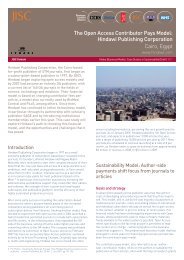A Concise Guide to Researching Audiences - Strategic Content ...
A Concise Guide to Researching Audiences - Strategic Content ...
A Concise Guide to Researching Audiences - Strategic Content ...
You also want an ePaper? Increase the reach of your titles
YUMPU automatically turns print PDFs into web optimized ePapers that Google loves.
2. Describing and defining thetarget audienceThis chapter discusses the importance of the target audiences and looks at ways of defining the targetaudiences, and approaches <strong>to</strong> audience segmentationKnowing who you would like your audience <strong>to</strong> be and what service you intend <strong>to</strong> offer is a vital part ofbusiness planning and service development.Both formal and informal approaches <strong>to</strong> defining the target audience are possible.Segmenting the audience in<strong>to</strong> different categories can be helpful when describing the target audience.2.1 The importance of the target audience2.1.1 Knowing who you would like your audience <strong>to</strong> be and what services you intend <strong>to</strong> offer is vital for anyservice. It may appear obvious, but it should be part of business planning as there are implications forfunding and potential routes <strong>to</strong> sustainability for a digital service.2.1.2 The characteristics of the target audience should influence the delivery of a service, the functionalityprovided, means of access etc. It is important <strong>to</strong> recognise that a service may have more than one distinctaudience. Needs and expectations of the different audiences are likely <strong>to</strong> be only partly overlapping and theimplications this has for service delivery should be considered.Case study extract… oldbaileyonlineA good illustration of audience-focused service developmentA project was funded <strong>to</strong> digitise the Old Bailey Proceedings <strong>to</strong> provide access <strong>to</strong> the text and scanned imagesof trial records. The project team was determined <strong>to</strong> create a resource that would reflect the needs of thedifferent target audience segments, and consultations with the target audience provided evidence for its bidfor funding, guided the design and features of the website, and guided the testing of the pro<strong>to</strong>type websiteand later redesign.The target audiences were identified on the basis of the content of the Proceedings and the project team’sprofessional experience of working in the London Archives, for example ‘community groups’ were identifiedas an important audience segment.Following consultation with the target audience, the design specification included features aimed at meetingthe needs of different audience segments. For example, it was discovered that some of the target audienceswere not familiar with 18th century his<strong>to</strong>ry, and that in the community groups segment schools were likely<strong>to</strong> be key users. Accordingly, a lot of background material was provided and dedicated ‘For Schools’ pageswere included <strong>to</strong> provide guidance for teachers on ways of using the Proceedings in teaching, and resourcestailored <strong>to</strong> school students including a timeline, glossary, tasks and primary source.This audience-focused approach was successful – the size of the audience for oldbaileyonline has exceededexpectations and the service is clearly widely used and appreciated. For further information on theoldbaileyonline, see the website (www.oldbaileyonline.org).2. Describing and defining the target audience PAGE 9



